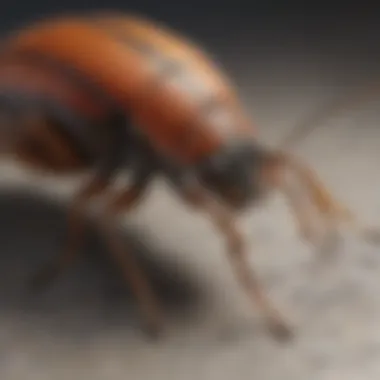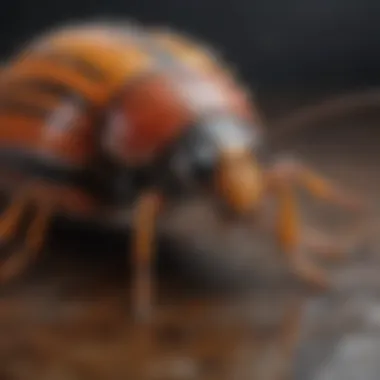House Bugs in NYC: Identification and Management


Intro
New York City is a bustling hive of activity, but it's not only humans who thrive in this urban jungle. Within its brick and mortar confines, numerous pests make themselves at home, often unbeknownst to the urban dwellers. An understanding of these house bugs is crucial for homeowners and renters alike who wish to maintain a comfortable living environment. From the persistent bedbug to the ubiquitous cockroach, each species brings its own flavor of annoyance and concern.
Identifying these pests and understanding their behaviors is the first step in any pest management strategy. Knowing how to spot an infestation early can save both time and money. With practical prevention tips and treatment options, this guide aims to arm readers with robust strategies for managing these unwelcome guests.
Pest Identification
Detailed descriptions of common pests
In the congested quarters of NYC, several house bugs frequently intrude upon household life. Take the bedbug, for instance. These tiny, flat insects are a nuisance, often hiding in mattress seams or behind headboards. An adult bedbug is about the size of an apple seed, reddish-brown, and with a body that becomes plump after a meal.
Then, there's the ever-so-common cockroach, a true survivor of urban life. Typically dark brown or black, adult cockroaches can grow up to 2 inches long. They tend to scurry away quickly, often seen in kitchens or bathrooms where food and water sources are plentiful.
While these two are frequently the main culprits, ants (especially the sugary-loving Argentine ant) and flies, can also be problematic. Ants usually stick to trails, searching for food, whereas house flies can breed rapidly, making them particularly bothersome during warmer months.
Signs and symptoms of infestations
Recognizing a bug encounter is more than just seeing the critter itself; it's about noticing the signs they leave behind. For bedbugs, bed bug bites can manifest as small, itchy welts usually in a line or cluster on the skin.
When it comes to cockroaches, residents might spot feces resembling coffee grounds or smears of a dark color near their hiding spots. Ants tend to march in lines, and you might find small holes in food packaging or grease stains leading to their nests.
Early detection can mean the difference between a simple fix and a full-blown infestation.
Prevention Strategies
Home maintenance tips for pest prevention
Keeping homes bug-free requires some groundwork. Regular cleaning is vital—vacuum carpets, wipe down kitchen surfaces, and don’t forget to address those hidden corners where crumbs might linger.
Here are a few practical maintenance tips:
- Seal cracks and crevices around windows and doors to prevent entry.
- Keep food stored in airtight containers, especially sugar and grains.
- Dispose of trash regularly and keep bins sealed tight.
Natural deterrents and barriers
Certain spices and natural elements can act as barriers against pests. For instance, peppermint oil works wonders as a natural cockroach repellent. Spraying a solution of water mixed with peppermint oil can deter these unwelcome visitors effectively. Moreover, using diatomaceous earth around entry points is a non-toxic way to deter different pests; it works by dehydrating insects that cross its path.
Treatment Options
Overview of chemical vs. natural treatments
When it comes to pest control, there are two main paths: chemical treatments and more natural alternatives. Chemical solutions can offer rapid eradication but may come with health risks and environmental concerns. On the other hand, natural remedies might take longer to show results but are typically safer for people and pets.
Step-by-step guides for DIY treatments
If you prefer to tackle pests with a hands-on approach, here’s a simple guide for a natural cockroach treatment:
- Gather your supplies. You will need baking soda and sugar for this remedy.
- Mix equal parts of baking soda and sugar. The sugar lures them in, while the baking soda kills them.
- Sprinkle the mixture in areas where roaches are spotted. Be patient; it may take a few days for results to show.
By taking the time to understand house bugs, you empower yourself in the fight against infestations. With proactive measures and informed treatments, you can keep your living space comfortable and pest-free.
Foreword to House Bugs in New York City
Understanding the dynamics of house bugs in New York City is crucial for both residents and property owners. Living in a bustling urban environment, the likelihood of encountering these pests increases significantly. They not only pose a nuisance but can also lead to various health risks and property damage. Being aware of the types of bugs that thrive in such conditions allows individuals to take proactive measures to manage them effectively.
Understanding Urban Pest Dynamics
Urban settings like New York City create a unique environment for pests. The crowded spaces and high foot traffic provide a veritable buffet for insects. High-rise buildings, old infrastructure, and proximity to waste disposal sites often form ideal breeding grounds. Bugs like cockroaches, bed bugs, and ants flourish here.
Insects adapt rapidly, finding their way into homes through the tiniest nooks and crannies. For example, cockroaches can slip through gaps as narrow as a dime. This adaptability makes them challenging to control. Understanding their behavior patterns—such as peak activity times and preferred habitats—can give residents a leg up in prevention.


Furthermore, seasonal changes also affect pest populations. Warmer months often see a spike in bug activity, while colder months might mean they seek shelter indoors. Recognizing these patterns is essential in developing effective pest management strategies, tailored specifically for the situation in New York City.
The Importance of Pest Control in NYC
Effective pest control is not just about aesthetics. It has significant implications for health and safety. Pests can carry allergens, trigger asthma attacks, and spread diseases. For an example, a single cockroach can produce allergens leading to respiratory issues in sensitive individuals. Similarly, bed bugs, although not known to transmit diseases, can cause considerable psychological and physical discomfort through bites that result in itching and sleep disturbances.
Moreover, neglected infestations often lead to larger, more expensive problems. It is much cheaper and easier to manage minor infestations than to deal with widespread issues that arise from prolonged neglect. Early detection and prompt action significantly mitigate the consequences of pest invasions, making knowledge and awareness essential.
Residents must adopt comprehensive pest control measures—this includes cleanliness, proper waste management, and timely inspections. Sharing these responsibilities collectively among neighbors enhances the overall effectiveness of pest management efforts.
"An ounce of prevention is worth a pound of cure"—this age-old adage rings especially true in the context of pest control in NYC.
With a clearer understanding of house bugs and their management, residents can navigate the complexities of urban pest dynamics with confidence. Being informed is not just about protecting your home; it’s also about creating a healthier living environment for all.
Common Types of House Bugs Found in NYC
Identifying the common types of house bugs in New York City is crucial for understanding how to manage them effectively. As urban areas teem with life, they also provide ideal habitats for various pests, which can lead to troubles for homeowners and renters alike. Knowledge of these insects helps residents protect their living spaces and maintain a hygienic environment. Each bug species brings its own challenges, including health risks and the potential for structural damage. This section dives into these bugs, allowing readers to be more savvy in their pest control strategies.
Cockroaches: The Unwanted Residents
Identification and Species
Cockroaches are some of the most persistent pests found within NYC homes. Known primarily for their resilience, they can survive in harsh conditions. The American cockroach, identifiable by its large size and reddish-brown color, and the German cockroach, which is smaller and light brown with two dark stripes on its back, are among the most common.
Their ability to reproduce quickly adds to the difficulty of eradicating them. Recognizing these species is a necessary step in tailored pest control. This knowledge allows homeowners to not just identify their specific type, but also understand their behaviors and habitats, thus crafting strategies suited to each species. For instance, the German cockroach favors warmth and moisture, often found in kitchens and bathrooms, while the American cockroach might prefer basements or crawl spaces.
Health Risks Associated with Cockroaches
The presence of cockroaches goes beyond nuisance; they can pose significant health threats. These creatures can carry pathogens and allergens that lead to asthma and allergies in sensitive individuals. The way they scavenge for food in unsanitary environments, including sewers and dumpsters, means they can transmit germs that lead to food poisoning and other illnesses.
In urban settings, understanding these health risks emphasizes the importance of addressing cockroach infestations promptly. It’s essential for people to realize that leaving such pests unchecked can have detrimental effects on their health and overall quality of life.
Bed Bugs: Hidden Threats
Signs of Infestation
Bed bugs have become a notorious problem for city dwellers. Often, signs of infestation can be subtle. Small reddish-brown stains on sheets or a musty odor in a room can indicate their presence.
People may also notice small bites on their bodies after sleeping, which are typically in a line or cluster. Observing these indicators early can prevent a minor annoyance from turning into a full-blown infestation. Awareness is the first line of defense against these troublesome pests.
Impact on Health and Well-being
The repercussions of a bed bug infestation extend beyond mere physical discomfort. Along with causing itchy welts, these pests can significantly affect mental health. Anxiety and stress levels can spike, especially considering the stigma attached to bed bugs.
Recognizing their impact on both physical and psychological well-being is critical. This dual nature of the threat underscores the necessity for prompt identification and treatment whenever signs of infestation appear.
Ants: Not Just for Picnics
Species Identification
Ants might seem harmless, but various species are prevalent in NYC homes and can wreak havoc. Common types include the carpenter ant, which can damage wooden structures, and the odorous house ant, which is known for its foul smell upon squashing.
Understanding the specific ant species can guide homeowners in their pest control efforts. Each type requires different approaches based on their foraging habits and nesting preferences, ranging from bait traps to extermination methods.
Intrusion Patterns
Ants typically have a predictable pattern when invading homes. They often travel in trails and can enter through tiny crevices and cracks. Being aware of these behaviors enables residents to take preventative measures, sealing entry points and eliminating food sources to make their dwelling less appealing.
Silverfish: The Quiet Dwellers
Behavioral Traits
Silverfish are often overlooked due to their elusive nature. These small, wingless insects are nocturnal and prefer dark, damp areas, such as basements or bathrooms. Their diet primarily consists of starchy materials, which can lead to damage to household items including books, wallpaper, and clothing.


By understanding their behaviors, homeowners can better monitor and manage these pests, reducing their chances of making a cozy home in one’s belongings.
Control Measures
When it comes to controlling silverfish, proactive strategies include minimizing moisture and sealing entry points. Regular cleaning and decluttering can also deter these insects. Not only does this keep the home tidy, but it also diminishes the resources available to silverfish.
Spiders: Beneficial or Problematic?
Common Spider Species in Homes
New York City houses several spider species, some helpful in pest control and others that raise concern. For instance, the common house spider can eat troublesome insects, while the black widow and brown recluse pose health hazards due to their venomous bites.
Familiarity with these spiders helps residents distinguish beneficial creatures from harmful ones, leading to more informed decisions about pest management.
Deterrents and Prevention
To keep spiders at bay, regular cleaning can make a lasting difference. Vacuuming corners, removing webs, and ensuring that food is stored properly can deter spiders from taking residence. Some natural deterrents, like essential oils, can also act as a barrier, reducing the likelihood of encountering these eight-legged creatures.
Each of these common pests requires a keen understanding for effective identification and management. Being informed empowers residents, enhancing their ability to maintain a pest-free living environment.
Identifying House Bugs: A Practical Guide
Understanding how to identify house bugs in New York City is crucial for effective management. With the city’s dense population and varied living conditions, infestations can occur seemingly overnight. A thorough knowledge of what pests to look for can save homeowners and renters a great deal of time and effort in dealing with these nuisances. By familiarizing yourself with both the physical characteristics and behavioral signs of common household insects, you can stay one step ahead in pest prevention.
Physical Characteristics of Common Bugs
When it comes to identifying house bugs, knowing their physical traits is fundamental. Different bugs have unique features that make them, quite literally, stand out. Here are some notable examples:
- Cockroaches: Typically brown or black, cockroaches have a flattened, oval body with long antennae. American cockroaches are particularly large, about 2 inches long.
- Bed Bugs: These tiny pests are about the size of an apple seed and appear brown. When fed, they take on a reddish hue and have a distinctive, flat shape.
- Ants: Ants can vary significantly in size based on the species. Carpenter ants, for instance, are larger and predominantly black, while odorous house ants are smaller and have a slight brown tint.
- Silverfish: These elusive creatures have a silvery-grey color, with a slim, elongated shape and three long tail-like appendages. They are quick and prefer dark, moist places.
- Spiders: While spiders aren't technically insects, they're common in homes. Brown recluse spiders, for instance, have a distinctive violin-shaped marking on their backs, whereas the more benign house spiders have a more rounded body.
Being able to recognize these physical characteristics not only aids in identification but also informs what steps you might take next. Consider the difference in treatment options if you're dealing with pesky ants as opposed to resilient bed bugs.
Behavioral Signs of Infestation
Identifying bugs goes beyond simple observation; their behavior tells a story. Patterns often reveal the extent of an infestation. Here are some signs to keep an eye out for:
- Visible Movement: Seeing bugs scuttled around during the day could indicate a larger infestation, particularly in cockroaches. They usually prefer hiding in dark spaces.
- Droppings: Finding tiny droppings can be a key signal. Cockroach droppings resemble coffee grounds, while bed bug excrement appears dark and rusty.
- Nymphs or Shed Skins: If you notice small, immature insects or discarded skins, it’s likely you have a larger problem on your hands. These nymphs are often difficult to catch at first, but seeing them indicates recent breeding.
- Unpleasant Odors: Some pests release odors. For instance, cockroaches emit a musty smell that can indicate significant activity.
- Damage to Property: Signs of damage can lead homeowners to suspect specific infestations. Chewed fabrics, wood shavings, or holes often point to specific pests such as bed bugs or termites.
Identifying these signs early can be a game-changer. The longer an infestation persists, the more costly and difficult it may become to manage it effectively.
By paying attention to both physical features and behavior, one can gain considerable insight into the nature of a pest problem. This understanding not only helps in taking proactive measures but also in making informed decisions about treatment options.
Preventative Measures Against House Bugs
Implementing preventative measures against house bugs isn't just a good idea; it's an essential part of creating a comfortable, livable space. In densely populated areas like New York City, where the hustle and bustle of daily life often leads to overlooked spaces, the importance of these measures becomes magnified. Bugs not only make your house their home but can also bring about health issues, damage property, and cause overall distress. This section emphasizes the importance of vigilance and proactive strategies to reduce the likelihood of infestations.
Home Maintenance and Hygiene Practices
Maintaining a clean home goes beyond aesthetics; it's a fundamental factor in pest prevention. Bugs are often attracted to unclean environments, so keeping your living space tidy should be a top priority. Here are some detailed practices to consider:
- Regular Cleaning Routines: Establishing a cleaning schedule can drastically reduce the presence of food sources for pests. Sweep the floors daily, especially in areas where food is consumed, and tackle spills immediately.
- Proper Food Storage: Bugs are notorious for being uninvited dinner guests. Ensure all food is stored in airtight containers. This keeps pests at bay and maintains food freshness.
- Declutter Spaces: A cluttered environment provides hiding spots for pests. Regularly sort through possessions, and consider donating or disposing of items that are no longer needed.
- Laundry Practices: Keep dirty laundry in bins with lids. Bugs are attracted to the smells of dirty clothes as well. Additionally, washing bed linens weekly can help mitigate risks from common pests, such as bed bugs.
Sealing Entry Points
Even the best-maintained home can fall prey to house bugs if there are easy entry points. Sealing these gaps and openings is a crucial step in an effective pest control strategy. Here’s what to focus on:
- Check Windows and Doors: Examine frames for gaps or cracks where bugs can sneak through. Installing weather stripping or door sweeps can create a tight seal.
- Examine Walls and Foundations: Look for cracks and holes in your walls and foundation. Small gaps may seem insignificant, but they can serve as invitations for pests.
- Use Screens Wisely: Installing fine mesh screens on windows and vents can keep bugs out while allowing fresh air in. Make sure to check for any rips or holes in existing screens.
- Address Plumbing Entry Points: Pipes and drains can also be a gateway for pests. Seal gaps around pipes entering the house, especially in kitchen and bathroom areas.
"An ounce of prevention is worth a pound of cure". In other words, taking these simple steps can save you significant stress and money down the road.
By implementing these home maintenance practices and sealing off entry points, residents can significantly lower the risk of house bugs setting up camp in their homes. This proactive approach not only enhances the comfort of living spaces but also ensures that proper environments are maintained, keeping both residents and their properties safe from unwanted guests.
Treatment Options for Infestations


Understanding the right treatment options for house bug infestations is key to maintaining a pest-free environment. In a place as densely populated as New York City, where small spaces can become breeding grounds for bugs, effectively tackling these pests is essential for both comfort and health. Choosing the right approach involves considering various factors, including safety, effectiveness, and environmental impact. This section breaks down the available treatment options, highlighting their benefits and any considerations to keep in mind.
Chemical Treatments: Pros and Cons
When it comes to chemical treatments for pest control, homeowners are often faced with a conundrum. On one hand, these products are quick and can be quite effective in eliminating unwanted bugs. On the other hand, there are potential risks associated with their use. Here are some pros and cons:
Pros:
- Fast Action: Chemical sprays and baits can quickly reduce pest populations. Residents may notice a marked decrease in bugs within a short timeframe.
- Target Specific Pests: Many chemical treatments are designed to target specific bugs, which can minimize collateral damage to beneficial insects.
- Widespread Availability: These treatments are readily available in stores or online, making them accessible to homeowners who prefer a DIY approach.
Cons:
- Health Concerns: Some chemical substances can be harmful to pets and children if not used properly. It's critical to follow safety instructions rigorously.
- Environmental Impact: Over-reliance on these substances can lead to adverse effects on surrounding ecosystems and contribute to pest resistance over time.
- Persistence of Residue: Chemical residues may linger in the environment, posing risks long after application.
Natural Remedies: Efficacy and Usage
For those seeking an alternative to chemical solutions, natural remedies offer a versatile approach to pest control. These methods generally prioritize safety for families and the environment. What's more, many everyday items can serve as effective solutions in the fight against house bugs.
- Diatomaceous Earth: This powdery substance can be sprinkled around entry points. Its fine, abrasive particles harm insects while remaining safe for humans and pets.
- Essential Oils: Using oils like peppermint, tea tree, or lavender can deter bugs. A few drops in a spray bottle with water can help create a natural repellent.
- Vinegar Solutions: Mixing equal parts of water and vinegar can be sprayed in infested areas. Its strong smell can keep bugs at bay.
While these remedies may not offer the instant impact of chemical treatments, they have the advantage of being less toxic and more eco-friendly. However, for persistent infestations, homeowners may need to combine these methods with more aggressive tactics.
Hiring Professional Pest Control Services
For severe infestations, hiring professional pest control may be the best route. While many homeowners consider this an extra expense, the benefits can outweigh the costs. Professionals bring expertise and experience that can be invaluable in effectively addressing pest problems.
- Expert Assessments: Pest control experts can accurately identify the specific type of infestation and recommend suitable treatment, which is essential for effective management.
- Integrated Pest Management: Professionals often use an integrated approach, combining various tactics—chemical treatments, natural remedies, and exclusion methods—to create a comprehensive pest control plan.
- Safety and Peace of Mind: With professionals handling the situation, homeowners can feel secure knowing the job is done safely and effectively, reducing the risk of health hazards associated with DIY treatments.
Ultimately, the best course of action depends on the specific infestation and the unique circumstances of each household. Homeowners should weigh all options available and consider what aligns best with their values and needs.
Debunking Common Myths About House Bugs
Understanding the misconceptions surrounding house bugs is essential for effective pest management. In an urban landscape like New York City, where living conditions can be conducive to infestations, eliminating false beliefs can lead to more effective prevention and treatment strategies. Many individuals dismiss or underestimate the impact of these pests, thinking they are either harmless or easily managed. This post aims to set the record straight by addressing prevalent myths about house bugs and replacing them with factual information.
Myths vs Reality
- Myth: House bugs are only a problem in unsanitary environments.
- Myth: All spiders are dangerous and harmful.
- Myth: Pest control treatments are always chemical-based and unsafe.
- Myth: All insects can cause disease.
- Myth: You can't prevent pests; if they come, they come.
- Reality: While a clean home certainly helps deter pests, it's not a fail-safe. Bugs like cockroaches or bed bugs can infest even the cleanest of spaces. Bed bugs are notorious hitchhikers, often caught in luggage or second-hand furniture regardless of the cleanliness of a home.
- Reality: Many spiders found in homes are actually beneficial. They can help control smaller insect populations and usually avoid human interaction. The majority of spiders are harmless, and understanding this can help lessen the fear surrounding them.
- Reality: There are numerous natural remedies available that are both effective and safe for households with kids and pets. Many pest control companies are also offering organic options that align with eco-friendly practices, emphasizing the importance of research before assuming the necessity of harsh chemicals.
- Reality: While certain pests, like cockroaches, can introduce allergens and pathogens into your environment, not every bug has the same effect. For instance, silverfish are more of a nuisance than a health threat. It is crucial to differentiate which bugs pose real health risks and which do not.
- Reality: Proactive steps can dramatically reduce the chances of infestation. Regular maintenance, sealing entry points, and maintaining hygiene standards are proven strategies to keep bugs at bay.
"Knowledge is power, but only if it’s accurate. Debunking myths empowers homeowners to take real steps against pests."
By debunking these common myths, readers can make informed decisions on how to approach pest control in their own homes. Laying these misconceptions to rest not only arms homeowners with the facts but also encourages safer, more effective pest management strategies that are applicable to New York City’s unique environment.
Finale: A Proactive Approach to Pest Management
In a bustling city like New York, house bugs are more than just a nuisance; they can affect our health and well-being, not to mention our peace of mind. Taking a proactive approach to pest management is essential not only for tackling current issues but also for preventing future infestations. This mindset encompasses a variety of strategies that go beyond the basic reaction to bugs appearing in one's space.
One of the foremost benefits of a proactive stance is the ability to identify potential problems before they spiral out of control. For instance, regular inspections can spot signs of pests early, giving homeowners a fighting chance to eliminate them before major infestations occur. Keeping an eye on common hiding spots—like behind appliances and under sinks�—reduces the likelihood of unwelcome guests taking up residence.
In conjunction with vigilance, maintaining cleanliness is critical. Bugs thrive in disorder, so a tidy living space is less appealing to them. Simple steps like vacuuming regularly, disposing of food waste promptly, and sealing food containers create an unfriendly environment for pests. Homeowners can also benefit from developing routine maintenance habits that include checking for cracks and crevices, ensuring windows and doors are fitted correctly, and addressing moisture problems, as many bugs are attracted to damp areas.
Moreover, understanding the lifecycle and behavior of various house bugs allows for targeted management strategies that are both effective and sustainable. For example, employing bait traps for cockroaches or using natural repellents might be more efficient than broad-spectrum insecticides. This not only keeps homes safer for pets and children but also minimizes the adverse environmental impact of pest control treatments.
Let’s not forget the power of education in empowering homeowners. By familiarizing themselves with the types of pests most commonly found in NYC apartments, individuals can better prepare against them. The common notion that pest control is solely the responsibility of professionals is misleading; homeowners have a significant role to play.
"Knowledge is power—knowing the enemy is the first step towards victory."
Ultimately, a proactive approach elevates pest management from a mere reaction to a comprehensive strategy. Time, effort, and consistent practices lead to an environment that’s resilient against infestation. By implementing what’s been discussed throughout this article, readers can not only tackle existing pest problems but ensure a long-term sanctuary for themselves and their families.
In closing, the key lies in a balanced mix of vigilance, cleanliness, maintenance, and education. If every homeowner takes a little time to prepare and implement these strategies, NYC can be a less buggy haven for everyone.



